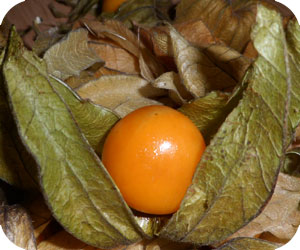|
Physalis Nutrition and
Health Benefits
The health benefits are
very good as this tropical fruit provides Vitamin C and
traces of the Vitamin B range. For more important
information about the benefits of vitamins and how they
can significantly improve your health, please refer to
vitamins in fruit
for essential and important facts. The nutritional value
is high, the fruit provides a good source of
potassium, iron, zinc, magnesium, calcium and phosphorus
- the potassium levels being particularly rich. |
|
|
Physalis
Nutrition Facts and Health Benefits
-
Physalis
fruit
nutrition: is sometimes called the golden berry. As you can see
by the Physalis picture to the right, this fruit is
enclosed in an unusual papery case often known by
the nickname Chinese lantern.
-
A popular type
is the Cape Gooseberry which is native
to Americas and also grown in South Africa. This
particular variety is high in pectin, a soluble fibre which not only aids the digestive system but
also helps jams and jellies to set.
-
Throughout
history, this fruit was grown in America,
Africa and parts of Europe including Greece, before
it was introduced to Great Britain in later years.
It has many health benefits to offer and is becoming
increasingly popular.
|
|
 |
|
Physalis Nutrition: Carbs, Calories
and Health Benefits
Physalis are low in calories,
slightly higher in carbs,
and a very good, small healthy fruit whether its eaten raw,
fresh, preserved or cooked. The amount of calories
in golden berries depends on the method the
fruit is served or cooked, for example if the fruit is
dipped in fondant icing, obviously it will contain more calories.
This fruit is extremely low in fat. The
following calorie guide can be used to calculate the
amount of physalis calories and carbohydrates:
Nutritional Information:
Calories in Physalis fruit per 100 grams (One Physalis
fruit weighs
approximately 6 grams)
Fresh, raw physalis
nutrition - 49
calories / 11 grams carbs in Physalis
Physalis
Nutrition: What is a Golden Berry Physalis?
Physalis
is
an unusual exotic fruit which grows on plants. The
fruit is unusual as it's encased in a papery
husk, hence the name Chinese Lantern Physalis
which is sometimes used.
This fruit is known by various names
including the Golden Berry, Inca Berry, Cape
Gooseberry and Golden Strawberry. The
Physalis fruit is small and uniquely tasting
to any other fruit, however, it is a distant
relative of tomato, potato, pepper and
aubergines which in some ways the Physalis
fruit shares similar flavors, as well a
cross with the taste of gooseberry or a
firm, small tomato. The popular species of
Physalis fruit is yellow to orange colored
with thin edible skin. There are other
species which vary in color and shape. |
|
|
|
Physalis Nutrition: How
to eat
Look for bright Physalis which are
undamaged and intact within their natural casing. The
fruit should keep for a few days in a cool place.
Physalis is delicious whether its eaten raw, on its own,
or cooked. This is an ideal fruit for making jam as it's
high in pectin which is a soluble fibre that helps jelly
and jams to set. Physalis are small and make lovely
dessert decorations for sweets such as gateau,
cheesecake, tarts or pavlova.
The Chinese lantern casing
cannot be eaten, however, try folding them back and
using them to hold the physalis fruit in place whilst
you did the fruit into chocolate or fondant icing. Some
of the popular varieties of Physalis other than the Cape
Gooseberry are the Tomatillo and the Chinese Lantern.
These varieties differ in color and appearance but they
are all members of the Physalis family. |
|
|
|
Health
experts and nutritionists believe that a well-balanced
diet that includes at least five portions of fruit and
vegetables per day will help to considerably improve our
lifestyles and ultimately extend our lives |
|
|
|
|